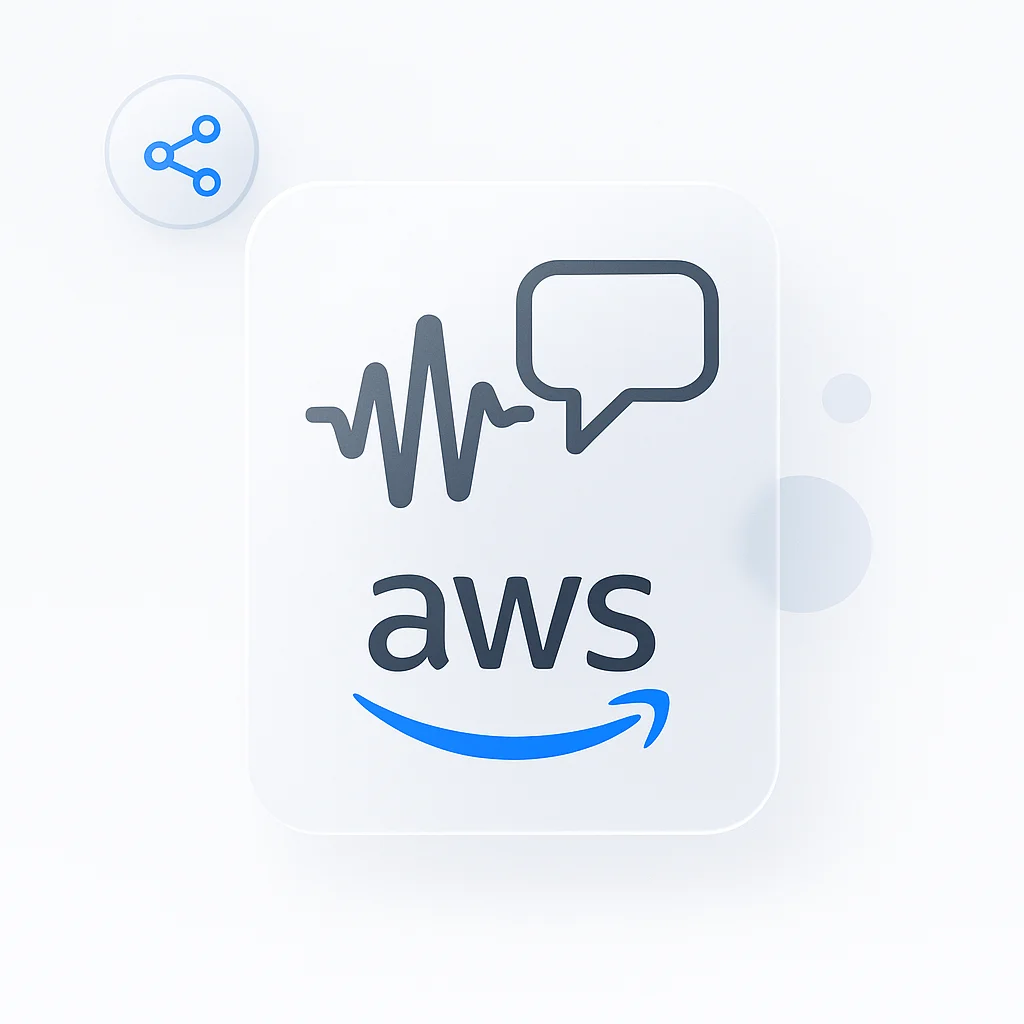¿Estás listo para desbloquear el poder de Amazon Transcribe y Amazon Web Services (AWS)? ¡No busques más! Esta guía completa es tu recurso definitivo para navegar por el mundo de la transcripción y la computación en la nube. Tanto si eres un profesional experimentado como si estás empezando, te cubrimos con instrucciones paso a paso, consejos de expertos y ejemplos del mundo real. Prepárate para revolucionar tu flujo de trabajo y llevar tus proyectos a nuevas alturas con el dúo dinámico de Amazon Transcribe y AWS. ¡Vamos a sumergirnos!
Introducción
La transcripción de audio está a la vanguardia de los avances tecnológicos que han mejorado enormemente la vida cotidiana de los seres humanos en las últimas décadas. La conversión del lenguaje hablado en texto escrito ha revolucionado la forma en que las personas trabajan en múltiples industrias. El Reconocimiento Automático del Habla (ASR) en particular, es un componente bastante común de este concepto, que nos ayuda de diversas formas, como a través de asistentes virtuales en nuestros dispositivos móviles y en aplicaciones de aprendizaje de idiomas. Las herramientas de transcripción han aumentado la accesibilidad y permiten el almacenamiento y análisis eficiente de datos en un espectro de diferentes campos.
Entre los muchos servicios de transcripción disponibles para el público en general, Amazon Transcribe se erige como un servicio innovador y versátil. Proporciona soluciones robustas para una plétora de empresas, así como para individuos que buscan desarrollar la transcripción automatizada de audio. En este artículo, intentamos abordar los intrincados detalles que conforman Amazon Transcribe, así como la sinergia que tiene con Amazon Web Services (AWS). También echamos un breve vistazo a la computación en la nube y las características clave de Amazon Transcribe que lo convierten en una herramienta ideal para el uso generalizado.
Amazon Transcribe
Amazon Transcribe es un pionero en el campo de los servicios de transcripción con respaldo tecnológico y fue diseñado para formar transcripciones escritas de la palabra hablada, con un enfoque principal en garantizar la conversión fluida de audio a texto. Las transcripciones creadas debían ser tanto legibles como compartibles, con espacio para el análisis y la búsqueda de palabras cuando fuera necesario. Amazon Transcribe, al igual que la mayoría de las herramientas impulsadas por IA de la era moderna, impulsa la eficiencia y aumenta la accesibilidad en todos los ámbitos para todo tipo de usuarios.
Se utiliza ampliamente en muchos dominios, pero sobre todo en las siguientes áreas:
- Aumentar la accesibilidad a los usuarios discapacitados
- Transcripción de conferencias y entrevistas grabadas
- Para indexación de contenido y fines de archivo
Amazon Transcribe es diverso en su concepción y satisface la creciente necesidad de una transcripción optimizada, al tiempo que garantiza que su conexión con el espacio web de Amazon proporcione a los usuarios un fácil acceso a las transcripciones creadas.
Características clave
Tecnología de Reconocimiento Automático del Habla (ASR)
El Reconocimiento Automático del Habla (ASR) es un componente clave de Amazon Transcribe, ya que está entrenado para identificar patrones del habla, palabras y frases habladas y es capaz de clasificarlos con precisión en consecuencia. Equipa algoritmos de aprendizaje automático para reconocer acentos y fluctuaciones de tono con el fin de garantizar la máxima precisión.
Transcripción multilingüe y específica del dominio
Amazon Transcribe es una herramienta universal que se adapta a múltiples idiomas y garantiza que esté bien versada en nichos de mercado. Es muy aplicable a varias industrias, ya que los modelos de lenguaje están ajustados al área específica, de tal manera que es capaz de identificar jerga especializada y crear transcripciones precisas, independientemente del contexto.
Opciones de modelo de lenguaje y vocabulario personalizado
Las opciones de modelo de lenguaje disponibles en Amazon Transcribe son ilimitadas dados los constantes avances que se realizan de forma regular. Las empresas pueden aumentar la precisión de las transcripciones producidas empleando a desarrolladores para alimentar y personalizar el vocabulario más alineado con su industria, de tal manera que los términos y la terminología específicos del dominio no se pierdan en la transcripción. Para obtener orientación adicional sobre la gestión de la configuración técnica o la alineación de la terminología, recursos como el Centro de ayuda de Dynadot pueden ser útiles, especialmente al integrar herramientas de transcripción con flujos de trabajo relacionados con el dominio.
Transcripción en tiempo real y procesamiento por lotes
Amazon Transcribe puede proporcionar transcripción en tiempo real, así como procesamiento por lotes con el fin de maximizar la transcripción y satisfacer las demandas necesarias. La transcripción en tiempo real es un activo que es más importante durante los eventos en vivo, ya que garantiza que todos los miembros de la audiencia puedan acceder al contenido casi al instante. El procesamiento por lotes es de particular importancia cuando se necesita transcribir grandes cantidades de datos en un corto período de tiempo; en lugar de gastar recursos para ejecutar transcripciones paralelas, procesarlo en lotes ahorra tiempo y esfuerzo.
Aprendizaje automático
Los servicios de transcripción se basan en el aprendizaje automático para acelerar el proceso y garantizar la precisión. Amazon Transcribe no es diferente; emplea el aprendizaje automático para garantizar avances constantes en la transcripción, para mejorar la precisión y la eficiencia. Implementa la ideología de que la práctica hace al maestro al aprender a adaptarse al lenguaje de nicho utilizado con cada nueva transcripción. Cuantos más datos se procesen a través de este sistema, más precisa será la transcripción con el tiempo. Esto garantiza que Amazon Transcribe pueda cumplir con los requisitos de cualquier empresa y ser considerado un proveedor de servicios confiable.
Computación en la nube
En nuestro mundo que se digitaliza rápidamente, la tecnología prevalece como una solución a la mayoría de los problemas que enfrentamos. Ya sea para calcular impuestos, hacer horarios o crear código, la tecnología avanzada ayuda a nuestro progreso. Un componente de la tecnología del que menos se habla pero que se usa ampliamente en todo el mundo es la computación en la nube, un servicio que ha revolucionado la forma en que almacenamos nuestros datos.
La dependencia del hardware local no es una opción tan viable últimamente, dada su capacidad limitada y, francamente, su voluminosa ropa exterior. El almacenamiento interno a menudo se considera aún menos, dados los complejos obstáculos que uno tiene que superar para garantizar que los archivos más grandes estén seguros y no estén completamente desfigurados en el proceso de compresión a menudo requerido.
Los servicios en la nube son flexibles y abarcan una variedad de servicios a través de Internet. Estos incluyen almacenamiento y redes, con un enfoque específico en la potencia informática y el análisis. Las empresas optimizan sus operaciones mediante la implementación de una arquitectura de nube sólida y el aprovechamiento de la gestión multi-nube para garantizar una gestión de datos y una escalabilidad del sistema sin problemas. La computación en la nube ha permitido a los usuarios depender menos del hardware físico y ha facilitado la navegación a través del software. Los usuarios pueden acceder y utilizar los recursos a través de los proveedores de servicios en la nube desde la comodidad de sus propios hogares con poca o ninguna experiencia en el campo; todo lo que realmente necesitan es una conexión a Internet estable.
¿Cómo funciona AWS?
Amazon Web Services es una plataforma de computación en la nube que ofrece una variedad de servicios a una amplia gama de industrias: desde empresas hasta desarrolladores profesionales e individuos que pueden buscar sus servicios para uso personal. AWS es versátil y flexible, lo que permite el crecimiento y la gestión de aplicaciones. Para hacer esto, emplea los siguientes componentes:
Componentes de AWS
Infraestructura global
AWS se considera una plataforma global, ya que abarca una variedad de regiones conocidas como “Zonas de disponibilidad” donde existen centros de datos físicos separados para almacenar datos y habilitar las redes. Es altamente disponible y tolerante a fallas debido a estos centros.
Servicios ofrecidos
Los servicios proporcionados por AWS son extensos y pueden variar desde el almacenamiento a través de Amazon S3 hasta la potencia informática a través de Amazon EC2. También incluye la retención de bases de datos a través de Amazon RDS y su propio administrador de aprendizaje automático conocido ampliamente como Amazon SageMaker. La combinación de estos servicios permite a los clientes cumplir con requisitos específicos y proporcionarles soluciones personalizadas para cualquier problema que puedan encontrar.
Consola de administración de AWS
La consola de administración de AWS es una interfaz web que permite la administración de otros servicios de AWS. Se considera una interfaz unificada y bastante fácil de usar que actúa como un centro centralizado para monitorear y escalar recursos, así como para la configuración. Comprender los precios de AWS S3 puede ayudar a optimizar la eficiencia de los costos dentro de la consola de administración de AWS.
Administración de acceso e identidad de AWS (IAM)
La administración de acceso e identidad de AWS (IAM) es un componente integral del sistema, ya que garantiza que los usuarios puedan administrar y autorizar el acceso a sus datos dentro de los servicios de AWS.
Integración con Amazon Transcribe
Utilización de la infraestructura
La integración de Amazon Transcribe con AWS aporta una plétora de beneficios, comenzando con la infraestructura global y bastante extensa de AWS, que ayuda a la transcripción eficiente dentro de Transcriber. Este aspecto particular garantiza la fiabilidad de las transcripciones, independientemente del volumen de información y a quién esté destinado a ser compartido.
Soluciones de almacenamiento (S3)
Las capacidades de computación en la nube de AWS son más prominentes en el componente Amazon S3 que actúa como un servicio de almacenamiento simple. Amazon Transcribe lo utiliza para garantizar el almacenamiento seguro de los archivos de audio, así como sus transcripciones correspondientes. Amazon S3 es duradero, lo que lo convierte en una excelente opción para el almacenamiento y garantiza que las transcripciones estén seguras y accesibles para el uso del cliente.
Integración con otros servicios (AWS Lambda)
La integración de los servicios de AWS fomenta la productividad y un flujo de trabajo más fluido, especialmente con componentes como Lambda, que calcula y automatiza las tareas que siguen a una transcripción, de tal manera que los clientes pueden extraer extractos de la transcripción y las funciones de Lambda les permiten usarlos en otros contextos. Las empresas pueden contratar expertos en tecnología a través de empresas como Smoothstack Inc para acceder a profesionales capacitados para administrar integraciones complejas.
Beneficios de usar Amazon Transcribe y AWS
Amazon Transcribe y AWS existen como servicios individualmente brillantes que, cuando se integran, ofrecen una extensa lista de beneficios dirigidos a muchas industrias, con muchos casos de uso para respaldar las afirmaciones. La relación dinámica entre el transcriptor y el servicio informático existe como resultado del ecosistema construido por Amazon para generar servicios de transcripción eficientes y beneficiosos en todo el mundo.
Rentabilidad
La implementación de un modelo de precios de pago por uso garantiza que los cargos realizados dentro de Amazon Transcribe sean solo por los servicios que los clientes utilizan en tiempo real, de tal manera que no hay necesidad de inversiones voluminosas antes del uso. Esto garantiza que las empresas puedan optimizar el uso de Amazon Transcribe y asignar los presupuestos necesarios de acuerdo con la urgencia de la transcripción.
Escalabilidad
AWS proporciona a Amazon Transcribe una escalabilidad que no tiene paralelo con la mayoría de los servicios de computación en la nube, ya que puede adaptarse a los cambios dinámicos en la demanda según la necesidad de transcripción. La elasticidad de AWS se suma a la capacidad del transcriptor para proporcionar transcripciones precisas y eficientes con un retraso mínimo (si lo hay) por su parte. Esto también ayuda a garantizar que siempre haya una comprensión clara de la disponibilidad de recursos y que el rendimiento se mantenga de manera lineal.
Flexibilidad y personalización
Los servicios que existen dentro de la plataforma AWS añaden un valor tangible a Amazon Transcribe, especialmente al proporcionar flexibilidad para combinar servicios complementarios cuando sea necesario y al permitir la personalización de los servicios para que se ajusten a la empresa con la que puedan estar trabajando. Esto ayuda a construir un flujo de trabajo que satisface demandas específicas al tiempo que garantiza la eficiencia a través de la transcripción automatizada y el procesamiento de datos optimizado. De manera similar, las empresas a menudo adoptan herramientas especializadas como el software de gestión de activos para obtener una visibilidad centralizada de los recursos físicos y digitales, mejorando el seguimiento, la elaboración de informes y la productividad operativa general.
Seguridad
La naturaleza segura de AWS garantiza que los datos dentro del Transcriber estén protegidos. AWS está equipado con medidas de seguridad que cumplen con los estándares de la industria, especialmente donde se pueden transcribir datos confidenciales. Emplea cifrado de datos y protección de red para garantizar que la información transcrita y almacenada se mantenga confidencial.
Innovación
Amazon Transcribe avanza constantemente para mantenerse al día con las crecientes demandas de los clientes, así como con la naturaleza rápidamente innovadora del aprendizaje automático. AWS se asegura de que se mantenga actualizado y esté integrado con los servicios necesarios para mejorar la precisión de las transcripciones creadas, de tal manera que estén en línea con el uso en el mundo real y coincidan con el nicho del mercado para el que puedan estar hechas.
Conclusión
Con cada avance e integración de nuevos componentes, Amazon Transcribe está revolucionando la forma en que procesamos la información y cómo integramos el contenido hablado en nuestros negocios, así como en el desarrollo profesional. La conversión de voz a texto ha ayudado a múltiples industrias al reducir a la mitad el tiempo requerido para comprender conceptos, obtener información y colaborar. Esto es especialmente cierto cuando el Reconocimiento Automático del Habla (ASR) se utiliza como un medio para garantizar que el proceso de convertir las palabras habladas en algo tangible y útil se mantenga bastante simple.
Las capacidades de Amazon Transcribe están influenciadas directamente por su integración con Amazon Web Services (AWS), que consta de una variedad de servicios específicos para optimizar el proceso de transcripción. Aunque originalmente es un servicio de computación en la nube, AWS está equipado con infraestructura estándar y otros servicios que garantizan un gran rendimiento, así como una seguridad sólida. Amazon Transcribe es capaz de aprovechar los poderes de AWS para crear transcripciones que se pueden integrar fácilmente en otros servicios complementarios.
Estas herramientas existen dentro de un ecosistema creado por Amazon para atender a profesionales y usuarios individuales por igual, superando la necesidad de transcripción al tiempo que expande su alcance en todo el mundo con características como las capacidades multilingües y el aprendizaje automático que lo equipan con el conocimiento necesario para extender sus servicios incluso a los mercados más especializados.
Comprender la forma en que funcionan Amazon Transcribe y AWS es fundamental para tomar decisiones prácticas sobre las herramientas de transcripción con las que se relaciona como cliente. Explorar sus capacidades y experimentar con su extensa lista de características le ayudará a determinar si Amazon Transcribe y AWS pueden ayudar a elevar su negocio a largo plazo.
Para maximizar la eficiencia de Amazon Transcribe, las empresas a menudo contratan ingenieros de AWS que se especializan en los servicios de IA de AWS. Estos profesionales pueden ajustar la precisión de la transcripción, integrar el procesamiento del habla en tiempo real y administrar soluciones de almacenamiento en la nube rentables.






